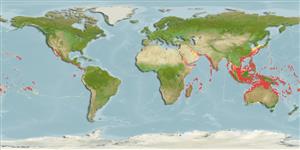Malacostraca |
Decapoda |
Dromiidae
Environment: milieu / climate zone / depth range / distribution range
Ecology
Benthic; depth range 5 - 112 m (Ref. 3174). Tropical
Indo-Pacific: From the Red Sea and East Africa to Hawaii and French Polynesia.
Length at first maturity / Size / Weight / Age
Maturity: Lm ? range ? - ? cm Max length : 20.0 cm CW male/unsexed; (Ref. 3174); 17.2 cm CW (female)
Carapace rounded, as wide as or slightly wider than long; surfaces convex, with dense pubiscence; 5 anterolateral teeth, median ones largest. No spine present on outer margin of dactylus of last walking leg. Color: light brown overall with pink fingers.
Largest dromiid known (Refs. 343, 122680). Epizoic. Subtidal on hard bottom (Ref. 106854). Occurs at depths of 5 to 50 m. Prefers moderately shallow waters with rocky-muddy substrates, sometimes near reefs. Omnivorous, feeds on sea stars. Carries sponges and colonial tunicates on its back for camouflage (Ref. 343). Can occasionally be found sheltering under old bivalve shells (Ref. 125338). Predator (Ref. 128960).
Life cycle and mating behavior
Maturity | Reproduction | Spawning | Eggs | Fecundity | Larvae
Members of the order Decapoda are mostly gonochoric. Mating behavior: Precopulatory courtship ritual is common (through olfactory and tactile cues); usually indirect sperm transfer.
Ng, P.K.L. 1998 Crabs. p. 1045-1155. In K.E. Carpenter and V.H. Niem (eds) FAO species identification guide for fishery purposes. The living marine resources of the Western Central Pacific. Volume 2. Cephalopods, crustaceans, holothurians and sharks. Rome, FAO. 1998. pp. 687-1396. (Ref. 343)
IUCN Red List Status
(Ref. 130435: Version 2025-1)
CITES status (Ref. 108899)
Not Evaluated
Not Evaluated
Threat to humans
Human uses
Fisheries: minor commercial
| FishSource |
Tools
More information
Population dynamicsGrowthMax. ages / sizesLength-weight rel.Length-length rel.Length-frequenciesMass conversionAbundance PhysiologyOxygen consumption
Human RelatedStamps, coins, misc.
Internet sources
Estimates based on models
Preferred temperature
(Ref.
115969): 22 - 29, mean 27.8 (based on 1662 cells).
Fishing Vulnerability
Low vulnerability (10 of 100).
Price category
Unknown.
